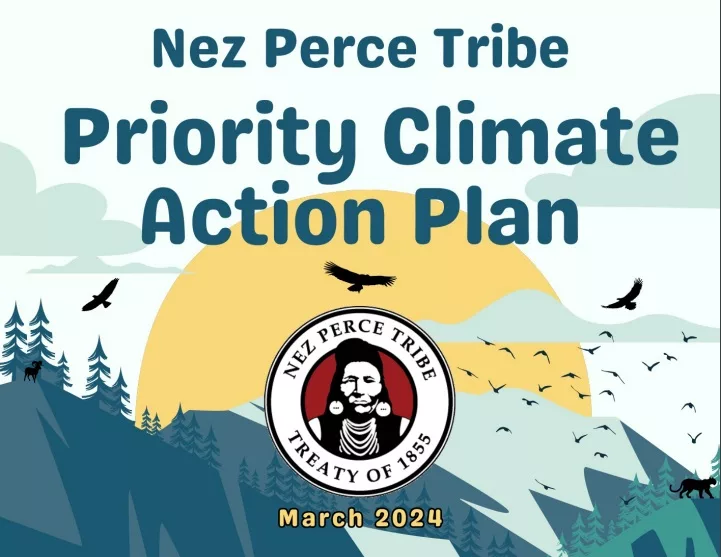
WASHINGTON, DC – The U.S. Environmental Protection Agency announced today that more than 200 Tribes – including the Nez Perce Tribe – plus American Samoa, the Northern Mariana Islands, Guam, and the U.S. Virgin Islands, have published climate action plans with financial support made possible by the Biden Administration’s Investing in America agenda.
“The Nez Perce Tribe applied for the CPRG planning grant to formalize its greenhouse gas reduction ambitions and to pursue implementation funding for climate change mitigation efforts that the Tribe has already been working towards. The Tribe recognizes the critical and urgent need to focus its efforts on mitigation to address the climate crisis,” the Nez Perce Tribe writes in its plan. “While the Tribe also recognizes the need for vulnerability assessments and adaptation, climate science very clearly demonstrates that dramatic actions must be taken rapidly to stop greenhouse gas emissions and reabsorb the excess carbon that is already in the atmosphere and oceans. Catastrophic climate change is upon us and threatens the lands, waters, and species the Tribe depends upon. Current extractive paradigms, resource management structures, and capacity are inadequate to address this crisis at the scale and speed needed. The Tribe applauds the CPRG as the most significant and comprehensive effort that the Federal Government has invested in to create meaningful change towards a healthier relationship between humankind, the atmosphere, and all the Tribe’s human and non-human relations.”
The regional plan adds that climate-driven disruption of biological communities has considerable ramifications for the Tribe’s culture and lifeways within and beyond administrative and treaty boundaries.
“As managers, the Tribe devotes substantial time, effort, and resources to the recovery and co-management of its treaty-reserved resources. The Tribe is leading on climate and demonstrating a determination to eliminate its carbon footprint while recovering ecosystems and species, protecting its people, and encouraging others to do the same,” the plan states.
The Nez Perce Tribe’s plan prioritizes five key sectors for carbon reductions that also support the Tribe’s social and economic priorities listed above. Those sectors include built environment, energy, transportation, natural land, and waste.
The overall planning process is supported by EPA’s Climate Pollution Reduction Grants program, which offers a unique opportunity for Tribal and territorial governments to develop strategies to reduce harmful pollution and address environmental justice concerns while building the infrastructure, industry, and competitive economy for a clean energy future. EPA received 81 plans in total from Tribes and Tribal consortia representing more than 200 Tribes, along with four plans from territories.
From the EPA:
“Climate change is an issue that affects Tribes disproportionately,” said Kenneth Martin, Director of EPA’s American Indian Environmental Office. “An unprecedented number of Tribes and intertribal partnerships worked with EPA to create Priority Climate Action Plans to remediate climate pollution in their communities. Thanks to President Biden’s Investing in America agenda, this is the first time that climate planning on this scale has been accomplished across Tribes. The measures proposed in these plans reflect an incredible opportunity to fight the climate crisis and benefit this and future generations.”
The Climate Pollution Reduction Grants program created under the Inflation Reduction Act — the largest climate investment in U.S. history — is enabling community-driven solutions to the climate crisis and helping accelerate America’s clean energy transition. The program is covered under President Biden’s Justice40 Initiative, which set the goal that 40% of the overall benefits of certain federal climate, clean energy, and other investments flow to disadvantaged communities that are marginalized by underinvestment and overburdened by pollution.
In 2023, under the first phase of the $5 billion program, EPA provided $250 million in grants to 45 states, the District of Columbia, Puerto Rico, 82 metropolitan statistical areas, four territories, and more than 200 Tribes (including Tribal consortia) to develop ambitious climate action plans that address greenhouse gas emissions across their communities and economies.
As a key deliverable of the initial $250 million planning phase of the program, EPA provided grantees with resources to develop and submit Priority Climate Action Plans focused on high-priority, implementation-ready activities to reduce GHG emissions. Plans developed by Tribes and territories were due on April 1, and plans developed by states and large metropolitan areas were due on March 1.
Each grantee has the opportunity of aligning its PCAP with its own priorities and interests, while also prioritizing measures that benefit low-income and disadvantaged communities. For many Tribes and territories, PCAPs are their first climate action plans. For others, the PCAPs build on existing climate and energy planning work undertaken over many years.
In addition to addressing climate pollution, these grants can also support efforts to:
- Ensure Tribes and territories are included in climate discussions at all levels of government, are part of the process to identify community-driven solutions, and benefit from their implementation.
- Improve public health through the simultaneous reduction of criteria and toxic air pollutants.
- Help businesses capitalize on new economic opportunities, spur financial growth and create jobs by supporting new industries and developing training programs to prepare workers.
PCAPs submitted to EPA lay the groundwork for the second phase of the CPRG program: $4.6 billion in competitive implementation grants, available specifically to planning grant recipients and other eligible entities, to fund GHG reduction measures contained within the PCAPs. In addition to the $4.3 billion general competition, Tribes and territories were eligible to apply for a $300 million Tribe and territory competition. PCAPs also help prepare Tribes and territories to access a broader set of funding opportunities, including other programs under President Biden’s Investing in America agenda. The deadline for the CPRG Implementation Grants Tribes and Territories Competition was May 1.
Over the coming months, all planning grant recipients will develop Comprehensive Climate Action Plans, which will include a broader suite of GHG reduction measures from all primary emitting sectors – electric power, transportation, commercial, and residential buildings, industry, agriculture/natural and working lands, and waste and materials management. The comprehensive plans will contain GHG emissions projections and reduction targets, air quality and health benefits information, and workforce planning assessments. EPA is committed to providing grant recipients with technical support, tools, and other resources throughout these planning processes.
Together, the CPRG planning grants and competitive implementation funding will support the deployment of technologies to reduce GHG emissions and other harmful pollution across the country, facilitate the transition to a low-carbon economy, promote Tribal sovereignty, and advance environmental justice by prioritizing public health and environmental benefits to overburdened communities.
View the Priority Climate Action Plans from CPRG planning grantees
More information on the Climate Pollution Reduction Grants
CPRG Training, Tools and Technical Assistance
Sign up for notifications about the Climate Pollution Reduction Grants program

